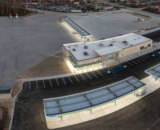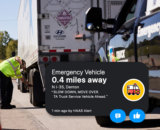Top 20 ADA Compliance Issues Seen in Truckstops and Travel Plazas is back! Join guest post contributor Brad Gaskins, The McIntosh Group every month for a new installment in his monthly column.
/// Guest post by contributor Brad Gaskins, The McIntosh Group
When it comes to toilet rooms, signage can seem like an obvious and easy last piece of the puzzle, but there are a few simple yet important ADA rules when it comes to these placards.
The two issues facility managers must consider when applying toilet room signage are height and placement.
Height
Having the toilet sign at the right height is important for persons with vision impairments who rely on tactile signs to identify the men’s or women’s restrooms. It should be easy for them to know at what spot on the wall they should feel for the signage.
The ADA rule here is that the sign should be mounted between 48 and 60 inches from the floor. Specifically, it should be no more than 60 inches from the floor to the top of the highest tactile character, and no less than 48 inches to the bottom of the tactile character.
Placement
Placing the sign at the right spot is essential to guiding a person with vision impairments.
The ADA rule here is that the sign must be located on a wall adjacent to the strike side of the door (where the handle is.) This allows a person who is using the tactile characters on the sign to easily find which door the sign applies to.
One of the most common mistakes we see is that the sign is mounted on the door itself. Think about it – if a person is using the raised characters to read the sign, and someone walks out of the bathroom, the door will swing out and hit the reader in the face. This is not the position that most of us want to put our customers in!
There is an exception if a) the door swings in, and b) there is no room for a sign on the wall adjacent to the strike side of the door, and c) there is no hold-open device on the door, then the sign may be mounted on the door. In such a case, the danger of the patron getting hit by the door is gone, and the location of the door is still easy to find.
Improperly Mounted Sign
Properly Mounted Sign
If you are remodeling, be sure that you or your contractor are placing the signs correctly. If your signs are already improperly mounted, the good news is that it’s usually an easy fix that you can probably do yourself.
/// Read more Top 20 ADA Compliance Issues Seen in Truckstops and Travel Plazas posts here.
Photo Credit: The McIntosh Group
The opinions and advice given by guest post contributors are not necessarily those of NATSO Inc. The posts should not be considered legal advice. Qualified professionals should be sought regarding advice and questions specific to your circumstances.
{Guest Post} Guest post provided by NATSO Allied member Brad Gaskins, The McIntosh Group. The McIntosh Group is an architecture firm focused on providing accessibility solutions for clients nationwide. Learn more about The McIntosh Group.
Subscribe to Updates
NATSO provides a breadth of information created to strengthen travel plazas’ ability to meet the needs of the travelling public in an age of disruption. This includes knowledge filled blog posts, articles and publications. If you would like to receive a digest of blog post and articles directly in your inbox, please provide your name, email and the frequency of the updates you want to receive the email digest.



